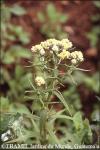1 WENIGER B, ROUZIER M, 1986 Enquête TRAMIL. Service Oecuménique d'Entraide SOE, Port au Prince, Haïti.
2 WENIGER B, SAVARY H, DAGUIHL R, 1984 Tri phytochimique de plantes de la liste TRAMIL. Laboratoire de chimie des substances naturelles, Faculté de Médecine et de Pharmacie, Université d'Etat d'Haïti, Port au Prince, Haïti.
3 WENIGER B, 1992 Pseudognaphalium viscosum (H.B.K.) W. A. Weber. Rapport TRAMIL. Faculté de Pharmacie, Université de Strasbourg, Illkirch, France.
4 SALEH NA, MANSOUR RM, EL-KAREEMY ZA, FAYED AA, 1988 The chemosystematics of local members of the subtribe Gnaphaliinae (Compositae). Biochem Syst Ecol16(7-8):615-618.
5 Villagomez-Ibarra JR, Sanchez M, Espejo O, Zuniga-Estrada A, Torres-Valencia JM, Joseph-Nathan P, 2001 Antimicrobial activity of three Mexican Gnaphalium species. Fitoterapia 72(6):692-694.
6 CACERES A, SAMAYOA B, FLETES L, 1990 Actividad antibacteriana de plantas usadas en Guatemala para el tratamiento de infecciones. Cuadernos DIGI 4-90.
7 españa SM, VELEZ DMP, CACERES A, 1994 Plants used in Guatemala for the treatment of gastrointestinal disorders. 5. Vibriocidal activity of five American plants used to treat diarrhea. Fitoterapia 65(3):273-274.
8 DUKE JA, 1992 Handbook of biologically active phytochemicals and their bioactivities. Boca Raton, USA: CRC Press.
9 DUKE JA, 1992 Handbook of phytochemical constituents of GRAS herbs and other economic plants. Boca Raton, USA: CRC Press.
10 WENIGER B, 1992 Gnaphalium, preliminary report inform to TRAMIL VI. Faculté de Pharmacie, Université de Strasbourg, Illkirch, France.
11 HERRERA J, 1992 Determinación de parámetros farmacológicos usados en medicina tradicional popular en la cuenca del Caribe. Informe TRAMIL. Dep. de Farmacología, Facultad de Salud, Universidad del Valle, Cali, Colombia.
12 CHRISTENSEN H, THOMAS T, (Eds.), 1973 The toxic substances list. Maryland, USA: U.S. Department of Health, Education & Welfare. p1001.
13 DE MEESTER C, ROLLMANN B, MUPENDA K, MARY Y, 1990 The mutagenicity of cassava (Manihot esculenta Crantz.) preparations. Food Addit Contam 7(1):125-136.
14 CARBALLO A, 1995 Cálculo de concentración y dosis de las drogas vegetales TRAMIL: Mensuraciones farmacognósticas y aproximaciones técnico-clínicas. Laboratorio provincial de producción de medicamentos. Sancti Spiritus, Cuba.










